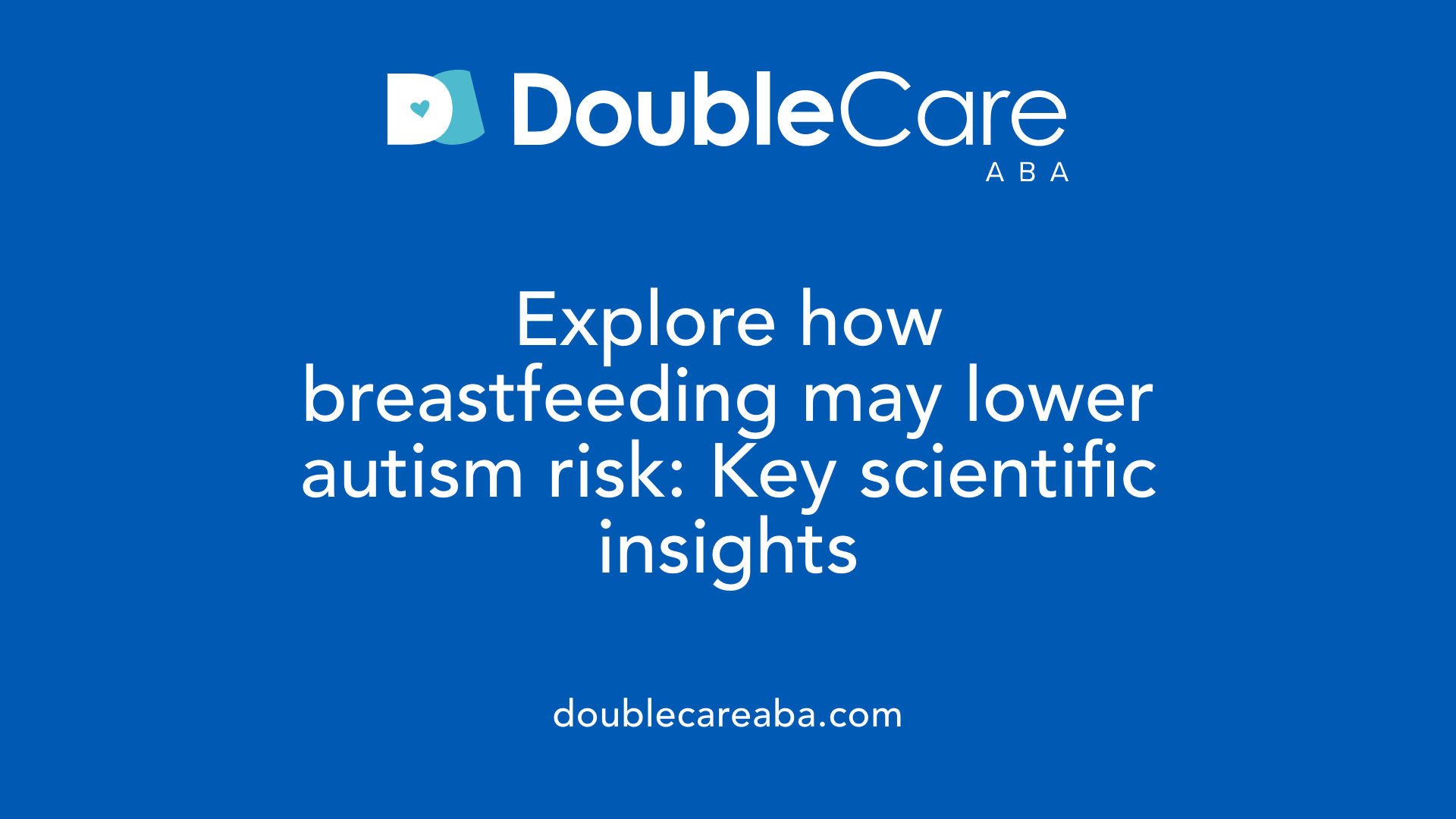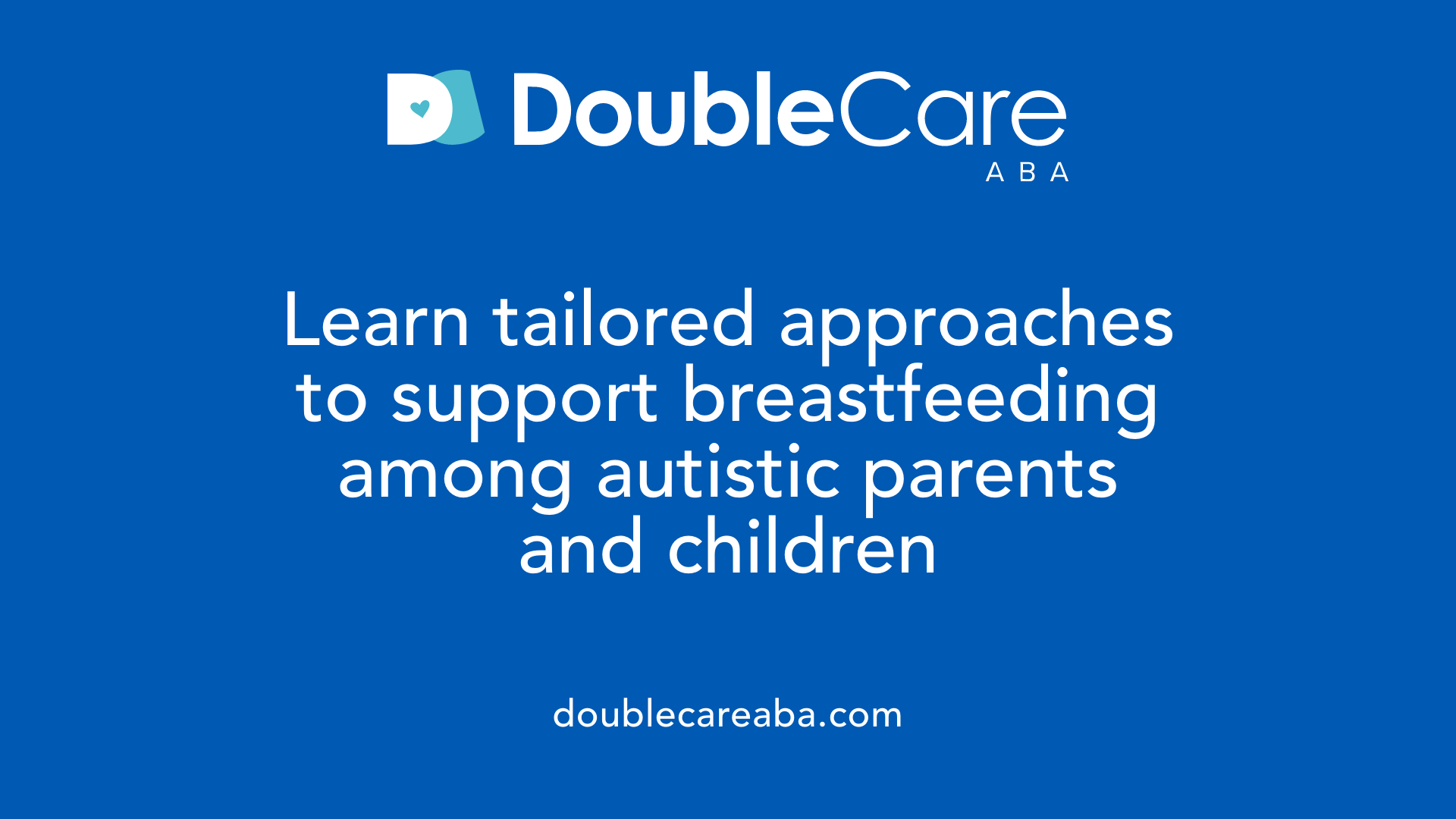Breastfeeding And Autism
Exploring the Connection Between Early Nutrition and Autism Spectrum Disorder

Understanding the Potential Link Between Breastfeeding and Autism
Recent scientific research suggests that breastfeeding may play a protective role against the development of autism spectrum disorder (ASD). While the relationship is complex and influenced by a multitude of factors, accumulating evidence points to longer and exclusive breastfeeding as beneficial in reducing ASD risk. This article explores the current findings, potential mechanisms, challenges faced by autistic mothers and children in breastfeeding, and the implications for future support and research.
Scientific Evidence on Breastfeeding’s Protective Role Against ASD
 Numerous studies and analyses support the idea that breastfeeding may help reduce the risk of autism spectrum disorder (ASD). A comprehensive meta-analysis that included seven observational studies, involving a total of 3,270 children, provides strong evidence for this relationship. The findings showed that children who were not breastfed had an 81% higher chance of developing ASD compared to those who were breastfed, highlighting a potential protective effect of breastfeeding.
Numerous studies and analyses support the idea that breastfeeding may help reduce the risk of autism spectrum disorder (ASD). A comprehensive meta-analysis that included seven observational studies, involving a total of 3,270 children, provides strong evidence for this relationship. The findings showed that children who were not breastfed had an 81% higher chance of developing ASD compared to those who were breastfed, highlighting a potential protective effect of breastfeeding.
The protective influence of breastfeeding appears to be dose-dependent. Longer durations of breastfeeding, especially extending beyond six months and up to 12–24 months, are associated with greater reductions in ASD risk. For example, children breastfed for 12 months or more showed a notable 54% decrease in ASD odds, and exclusive breastfeeding at 4 months mediates the relationship between delivery mode and ASD-related behaviors.
When comparing exclusive breastfeeding with partial or any breastfeeding, the data suggests that exclusive breastfeeding offers the most significant benefit. Children exclusively breastfed demonstrated a 76% reduction in ASD risk, while those breastfed in any form exhibited a 58% decrease.
Despite these findings, breastfeeding does not seem to affect the severity of ASD symptoms or related cognitive abilities. Studies analyzed show no significant impact of breastfeeding duration on measures like IQ or behavioral severity scales. However, children who were breastfed tended to have better daily living skills.
For autistic mothers and their children, supporting breastfeeding can be beneficial, but it also requires understanding their unique sensory and communication needs. Encouraging tailored breastfeeding support and strategies can make a significant difference. Overall, fostering breastfeeding practices remains an important aspect of early neurodevelopment consideration, with evidence suggesting it may contribute to lowering ASD incidence.
The Complexity of Breastfeeding and ASD Risk: Insights from Recent Studies

What do large cohort studies reveal about breastfeeding and autism spectrum disorder (ASD)?
Recent research highlights a potential protective effect of breastfeeding against ASD. A notable meta-analysis of seven observational studies involving 3,270 children found that children who were ever breastfed experienced a 58% reduction in ASD risk, with exclusive breastfeeding associated with an even greater decrease of 76%. Importantly, longer durations of breastfeeding, especially between 12 and 24 months, correlated with the most significant reduction in autism risk.
The studies also indicated that not breastfeeding increased the likelihood of ASD, with an odds ratio of 1.81 (95% CI, 1.35–2.27). These findings were consistent across the included studies, which showed no significant heterogeneity (I^2=0%), suggesting reliable results. Furthermore, breastfeeding appears to support neurodevelopmental health through mechanisms such as immune regulation and maintaining a healthy gut microbiome.
Are there contradictions and limitations in the current research?
While evidence points to a beneficial link between breastfeeding and lower ASD risk, some studies report no difference in severity of ASD symptoms based on breastfeeding history. For example, a study involving 243 children aged about 10 years found that breastfeeding did not affect the clinical severity or cognitive levels in children with ASD, although breastfed children demonstrated better daily living skills.
Additionally, some meta-analyses suggest that the protective effects of breastfeeding may diminish when strict diagnostic criteria and confounders are considered. There is also ongoing debate about whether shorter breastfeeding durations among children with ASD reflect early signs of developmental differences rather than causal factors.
Overall, while multiple studies support breastfeeding as a beneficial practice in reducing ASD risk, limitations such as variability in study design, population differences, and the complex interplay of biological and environmental factors mean further research is essential. Nevertheless, public health strategies promoting extended and exclusive breastfeeding remain a promising avenue for early intervention.
| Study Focus | Main Findings | Limitations |
|---|---|---|
| Observational meta-analyses | Breastfeeding lowers ASD risk; longer duration offers greater protection | Possible confounding factors; causal relationships unclear |
| Individual cohort studies | No significant impact on ASD severity; some association with daily skills | Recall bias; variable diagnostic criteria |
| Delivery mode and feeding practices | C-section linked with delayed breastfeeding, which correlates with ASD-like behaviors | Difficult to separate causation from correlation |
In summary, current research underscores the importance of breastfeeding in potentially reducing ASD risk, but it also highlights the need for ongoing, nuanced investigations to untangle the complex relationship.
Breastfeeding and Autism Severity: What Does the Evidence Say?
Do breastfeeding have an impact on autism-like behaviors or diagnosis?
Research on the connection between breastfeeding and the severity of autism spectrum disorder (ASD) symptoms is still evolving. While some early studies suggested that longer or exclusive breastfeeding might reduce the risk of ASD or lessen its severity, recent comprehensive research offers a more nuanced view.
A significant study involving 243 children diagnosed with ASD looked into how breastfeeding affected their symptoms and development. It found that children who were breastfed tended to score higher in daily living skills, which reflect adaptive and functional abilities. However, interestingly, breastfeeding duration did not show a consistent link to measures of ASD severity, intelligence, or behavioral issues like social skills or repetitive behaviors.
Another large-scale study using electronic health records analyzed the patterns of breastfeeding and ASD diagnosis. It revealed that both exclusive and partial breastfeeding were associated with lower odds of ASD diagnosis. Specifically, breastfeeding for more than 12 months was linked to decreased ASD risk. Conversely, introducing solids after 6 months was associated with increased autism-like behaviors. Yet, these findings do not establish causality; shorter breastfeeding periods in autistic children might reflect early difficulties with feeding due to sensory or communication differences, rather than being a cause of ASD.
Autistic children often experience sensitivities that can make breastfeeding challenging, such as hypersensitivity to touch, noise, or milk flow. Such sensory issues may lead to shorter breastfeeding durations but do not necessarily contribute to the development or severity of autism.
In summary, current evidence suggests that breastfeeding, especially when extended, might support better adaptive skills but does not directly influence the severity of autism symptoms. The relationship is likely complex and influenced by multiple factors, including sensory sensitivities and early developmental differences.
| Study Aspect | Findings | Additional Details |
|---|---|---|
| Influence on ASD diagnosis | Longer breastfeeding associated with decreased odds | aOR < 1 for >12 months breastfed children |
| Impact on severity | No significant effect on severity measures | IQ, behavioral scales, ADOS scores |
| Feeding challenges | Sensory and communication differences affect breastfeeding | Can lead to shorter durations |
| Overall | Evidence does not confirm causation | Feeding difficulties often related to autism features |
This area of research highlights the importance of supporting autistic families with personalized approaches to feeding, considering sensory and communication differences. While breastfeeding has many benefits, its direct impact on reducing ASD severity remains inconclusive.
The Biological Mechanisms Linking Breastfeeding and ASD Prevention
Can breastfeeding influence autism outcomes or strategies for autistic mothers and children?
Research indicates that breastfeeding may have a protective role against autism spectrum disorder (ASD). A comprehensive meta-analysis examined seven observational studies with over 3,200 participants, revealing that infants who were not breastfed faced an 81% higher chance of developing ASD. The protective effect tends to increase with longer breastfeeding durations, particularly beyond six months, and is most significant when breastfeeding extends to 12–24 months.
While breastfeeding doesn't seem to alter the severity of ASD symptoms or behavioral measures in children diagnosed with ASD, it has been linked to better adaptive skills in daily living. For autistic mothers and their children, encouraging breastfeeding and providing tailored support can be beneficial. Nevertheless, given the complexity of autism, ensuring strategies are personalized and supportive is essential. Further research is needed to understand how breastfeeding influences autism-related outcomes fully.
Unique Challenges Faced by Autistic Mothers and Children in Breastfeeding
Autistic mothers and their children often face specific challenges related to breastfeeding, stemming from sensory sensitivities, communication differences, and motor skills. Many autistic individuals experience heightened sensitivities to touch, sounds, and feeling of overstimulation, which can make breastfeeding a daunting experience. For example, hypersensitivity to the milk ejection reflex (let down) or noise in the environment can cause discomfort or distress for both mother and baby. Motor challenges may also influence the ability to position the baby comfortably or sustain proper latching.
Communication variations can complicate the early breastfeeding process. Autistic mothers might find verbal cues or support from healthcare providers insufficient or difficult to interpret, necessitating personalized and clear communication strategies. Moreover, feelings of stress or anxiety due to sensory overload or unfamiliar routines could hinder the breastfeeding experience.
Support strategies and individualized care are vital to address these challenges. Creating a calm, sensory-friendly environment can significantly ease the process; for example, dimming lights, reducing noise, and using calming techniques. Autistic mothers often benefit from self-management approaches such as using nipple shields, engaging in breastfeeding in a quiet space, or requesting assistance with positioning.
Healthcare providers should recognize the unique sensory and communication needs of autistic parents. Asking for permission before physical support, providing clear, concise instructions, and adapting techniques can foster a supportive environment. Tailoring support to accommodate sensory sensitivities and offering alternative feeding options like pumping or formula can also be beneficial.
Both autistic mothers and parents benefit from individualized care plans that respect their experiences and preferences. This approach not only supports successful breastfeeding but also promotes mental well-being and bonding, despite the sensory and communicative challenges faced.
Supporting Autistic Women and Children in Breastfeeding Efforts

How do sensory differences affect breastfeeding for autistic individuals?
Many autistic individuals experience sensory sensitivities that can make breastfeeding more challenging. These sensitivities can include over- or under-responsiveness to touch, noise, and other stimuli. For instance, some autistic women may find the milk ejection reflex (let-down) uncomfortable or overwhelming, or they might be sensitive to the textures of breast milk or the sensation of sucking.
Sensory overload during breastfeeding can lead to discomfort, distress, or aversions, which may result in shorter breastfeeding durations or difficulties during feeding sessions. Understanding these sensory differences is essential for providing appropriate support.
What alternative communication methods can support autistic breastfeeding parents?
Autistic parents may experience communication differences that can affect their breastfeeding experience. Utilizing alternative communication techniques, such as visual aids, sign language, or social stories, can help clarify instructions and express needs more effectively.
Healthcare providers should encourage the use of these strategies to improve understanding and comfort during breastfeeding. Clear, direct communication helps build trust and ensures that parents feel supported and empowered.
Support from healthcare providers and tailored interventions
Supporting autistic women and children in breastfeeding requires personalized approaches. Healthcare professionals should assess each individual's sensory profile, preferences, and challenges to develop tailored interventions.
This may include:
- Creating a sensory-friendly environment—dim lighting, minimal noise, and comfortable seating.
- Allowing breaks during feeding if overload occurs.
- Using tools like nipple shields or pumps to reduce discomfort.
- Providing written or visual guidance to supplement verbal instructions.
Autistic parents often express a strong desire to breastfeed despite difficulties. With individualized support and understanding, they can achieve positive breastfeeding experiences.
Additional resources and strategies
For more detailed information, search terms like "autistic parent breastfeeding support" and "sensory-friendly breastfeeding techniques" can offer practical tips and community insights.
Supporting breastfeeding among autistic families requires awareness of unique sensory and communication needs, along with flexible, personalized support strategies. This approach helps ensure that both autistic mothers and their children have the best possible start in their feeding journey.
Cultural, Social, and Personal Factors Impacting Breastfeeding in Autism

How do cultural and religious influences shape breastfeeding practices among autistic women?
Cultural and religious beliefs play a significant role in guiding breastfeeding practices. For instance, in Islam, the Qur’anic guidance recommends a breastfeeding period of two years, which aligns with scientific findings suggesting benefits of extended breastfeeding for neurodevelopment.
Such cultural norms can encourage mothers to breastfeed longer, supporting recent studies that associate longer breastfeeding durations—up to 24 months—with reduced risks of autism spectrum disorder (ASD). These practices can help mothers make informed decisions that align with their cultural values.
What personal preferences and experiences influence breastfeeding among autistic parents?
Autistic women often report that breastfeeding provides calming effects and a sense of empowerment. However, sensory sensitivities—like hypersensitivity to touch, sounds, or milk flow—may pose challenges during breastfeeding.
Many autistic mothers prefer self-management strategies such as breastfeeding in a quiet environment, using nipple shields, or asking others for support. Some may choose pumping or formula feeding to accommodate their sensory needs and reduce overstimulation.
What challenges do autistic mothers face, and what support do they need?
Autistic parents can encounter specific challenges, including sensory overload, misunderstanding from healthcare providers, or difficulties with traditional breastfeeding techniques. These issues can lead to feelings of distress or frustration.
To overcome these hurdles, personalized support is vital. Healthcare professionals should provide clear, sensory-friendly guidance, ask permission before touch, and tailor assistance based on individual preferences. Access to peer support groups for autistic mothers can also offer shared understanding and practical advice.
By acknowledging these cultural, social, and personal factors, healthcare systems can better support autistic women in their breastfeeding journeys, promoting positive outcomes for both mother and child.
Conclusion: Emphasizing Support, Research, and Awareness
Research indicates that breastfeeding, especially when exclusive and extended over several months, may be linked to a lower risk of autism spectrum disorder (ASD). Studies show that ever breastfeeding can reduce ASD odds by 58%, while exclusive breastfeeding offers a 76% reduction. The most significant decrease in risk is associated with breastfeeding for 12–24 months, highlighting the dose-dependent relationship between breastfeeding duration and ASD risk reduction.
While breastfeeding does not seem to influence the severity of ASD symptoms or cognitive outcomes, it appears beneficial in neurodevelopmental aspects like daily living skills. Importantly, longer durations of breastfeeding are associated with healthier microbiome development and support hormonal pathways that may protect against ASD.
However, not all children or autistic parents experience breastfeeding the same way. Sensory sensitivities—such as hypersensitivity to touch, sounds, and milk let-down—can present challenges. Autistic parents often benefit from tailored, individualized support that considers their unique sensory and emotional needs, with strategies like calm environments, nipple shields, or alternative feeding methods.
Looking ahead, further research is needed to unravel the biological mechanisms behind these associations and to develop comprehensive support strategies for autistic families. Enhancing awareness and understanding among healthcare providers will ensure that autistic parents receive respectful, personalized guidance. Embracing these insights can foster more inclusive, supportive environments where neurodiverse families can thrive.
Summary and Future Directions
While current evidence supports a potential protective role of breastfeeding against ASD, it is clear that the relationship is complex and influenced by various biological, genetic, and environmental factors. Supporting autistic mothers and children through personalized breastfeeding strategies and increased awareness can optimize early development. Continued research is essential to clarify mechanisms and improve interventions, ultimately fostering inclusive, supportive environments for autistic individuals and their families.
References
- Association of breastfeeding status with risk of autism spectrum ...
- Not breastfeeding and risk of autism spectrum disorders among ...
- Breastfeeding is not a risk factor for clinical severity in Autism ...
- Breastfeeding and Autism - La Leche League GB
- Impact of caesarean delivery on children's autism-like behaviours
- Breastfeeding patterns in infants are associated with a later ...
- The Interplay Between Breastfeeding and Autism Spectrum | medRxiv
- Breastfeeding patterns in infants are associated with a later ...
- Breastfeeding duration and neurodevelopment: insights into autism ...
- Breastfeeding - National Autistic Society
















